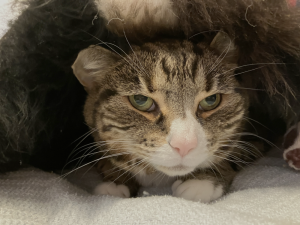Plus advice on structuring non-fiction, The Pembrokeshire Murders and a Grabbity burrito.
Hi there,
I’m now well into the third week of the worst cold I’ve ever had and my brain has been foggy to say the least. But let’s see if I can at least pull together a few coherent sentences for you!
Suw’s News: When not to submit
A couple of weeks ago I mentioned that Liverpool-based LA Productions had a script submission window open until 6 April. I thought hard about revising the pilot of Tag so that it would be ready for submitting, but this damned cold put paid to that.
However, I also spent some time looking up their past work and it’s all gritty drama, including Jimmy McGovern’s Moving On. If I sent them an urban fantasy that requires lots of CGI, well, I can imagine the looks on their faces. Even if I had been well enough to do the revisions, it still wouldn’t have been a good fit. Sometimes, the decision not to submit is the right decision.
Read this: Create a Character Clinic
The feedback I got from my script editor for Tag made me realise that I needed to go back and do some serious development work on at least two characters. I’d got Holly Lisle’s Create A Character Clinic ebook in a Humble Bundle a while back and, after just a quick look, decided to buy the full clinic including worksheets, as it’s only $3.99. It has been well worth the money.
Lisle guides you through a series of questions to ask your characters which slowly builds up a picture of how your character thinks and operates, what their past, present and future look like, and how they think about themselves. It gives you a well-rounded view of your characters, more so than some of the character sheets I’ve tried in the past. Lisle also advises that you keep some question in reserve so that you have something to go back to if you get stuck whilst writing, which is smart advice.
I’ve found Create a Character to be the most useful character development framework I’ve ever used and I honestly can’t recommend it enough.
Read this, two: Why do so many action heroes have names beginning with J?
John Wick, Jason Bourne, Jack Reacher, John McClane, James Bond, Jack Bauer, John James Rambo. Just why do so many action heroes have names that begin with the letter J?
Demetria Glace looked at the data for 790 movies “featuring an everyman-type lead” that have been released over the last 70 years. She found that 33 per cent of the lead male characters have names that start with a J, whereas the letter M came in second place with just seven percent of the action heroes listed. The explanatory theories are various, including that these names are just more common, that they represent the everyman (think “average Joe” or “honest John”), that auteur filmmakers are naming their heroes after themselves, or that the sound J names make is just more positive and heroic.
You’ll have to read the whole article to find out which, if any, of these theories holds water!
Read this, three: Advice on structuring non-fiction
Developmental editor Laura Portwood-Stacer has a great thread about the issues that she sees in scholarly book manuscripts, and her advice holds very true for any kind of non-fiction book. She lists ten issues that she commonly comes across, most of which are pretty easy to fix if you’re alert to the potential problem, starting with:
10. Chapters lack clear internal structure.Fix this with section headings (3–5 is a good number) that signal how each part of the chapter contributes toward the chapter’s overall purpose/argument—and make sure each part of the chapter actually does contribute
Review: The Pembrokeshire Murders

The Pembrokeshire Murders on itvX showing that you can write great drama whilst sticking to the facts.
I binge-watched (if you can binge a three-parter) The Pembrokeshire Murders over the weekend, the 2021 true crime drama from ITV which follows a six-year investigation into three three crimes – two double murders and an attack on five children including a rape and sexual assault – that had happened between 1985 and 1996.
I enjoyed it immensely and, as with any ‘based on a true story’ series, as soon as I finished it I had to immediately look up just how accurate it is. There are some fairly astonishing twists in the story, so I was surprised to find out that it follows real life events very closely, except for some understandable obfuscation of the identities of some those involved.
It’s a pleasant relief to find a dramatisation of real events sticking to the facts, particularly when so often the liberties taken with real stories are unnecessary. I’m thinking particularly of Ammonite’s invention of a lesbian relationship for palaeontologist Mary Anning when there’s no evidence that she had any romantic relationships with anyone.
Whilst real life rarely gives us neat and tidy stories with the dramatic arcs we expect of TV, The Pembrokeshire Murders shows it’s possible to let a real story sing without making half of it up.
Tweet of the week
my best writing advice is to have a secret project that no one knows about and that you also never work on
Obligatory cat picture
I’ve been hand-piecing a patchwork sheepskin rug for a friend over the last couple of months. Sunday, I had nearly finished when Grabbity decided that she needed to burrito herself inside it.
That’s it for this week!
All the best,
Suw
{ Comments on this entry are closed }





